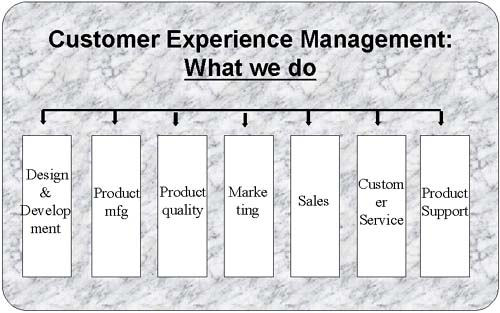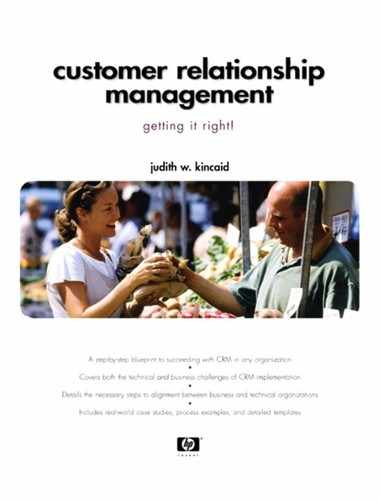2.2. Seeing the Total Customer Experience
The total customer experience is what a customer feels as a result of all the interactions he has had with your company, combined with other experiences and information he has gained from the external marketplace. It's not something you do, but it is the result of many things you do, combined with other influences that come from outside our direct control. We can certainly impact the total customer experience (for better or for worse), and we should definitely measure it to know how we're doing.
There are three major vectors that influence the customer's total experience: the external marketplace, your company's brand image, and all the different ways the company touches your customers. Total customer experience describes what the customer feels about the sum of her experiences with a company.
The customer's total experience is the result of matching experience to expectations. Meeting or exceeding expectations yields loyalty, while a negative match yields disloyalty. One of the most important yardsticks that we can use to measure how well we are doing is to monitor the customer experience. We can gather objective information through indices of customer loyalty such as retention rates versus turnover or brand awareness and value. Subjective data can be collected by asking customers to tell us how we are doing in all the important ways we impact them. Then we need to compare the trends these measurements against the trends in our financial results.
As illustrated in Figure 2-5, some of the influences that set customer expectations are external, and we have little control over these. But many are internal, under our direct control.
Figure 2-5. The total customer experience

We must understand what factors make up the customer experience and where we have control and can influence that experience.
2.2.1. What the Market Says (or Does)
What's happening in the market has a strong impact on setting customer expectations. We've already discussed that the Internet (access, control, speed, globalization, and automation) has changed customer expectations dramatically. Other strong external influences come from analysts and the media—what is being said about our industry as a whole as well as our company specifically. The media also set expectations about what's on the horizon for the types of products and services we sell. Of course, what our competition is saying and doing is another big factor in shaping customer expectations. Financial analysts, the stock market, and how the economy itself is perceived to be doing are also major influences, as illustrated in Figure 2-6.
Figure 2-6. What customers hear

We do have the ability to influence the marketplace with press releases and other forms of communication, but in general, this is the lever that is least available for our use in influencing the customer experience.
2.2.2. What We Say
One of the most important influences on the total customer experience is what we tell him he should expect from us. Our brand position, the image we establish in the marketplace, is a key element in setting expectations. Many think of a brand as simply a trademark, logo, company or product name, or visual identity. The problem with these traditional definitions is that they are too internally focused (product-centric, ignoring the importance of representing value to the customer), too superficial (just a graphic design), or too tactical (failing to recognize how brand must shape the strategic planning and direction of the whole company because of its influence on setting customer expectations).
|
A brand is generally built on a small number of attributes that you have chosen to paint a picture of what your company is (e.g., high quality, good service, friendly, trustworthy, etc.). These brand attributes should support your company's chosen value discipline. You must then operate consistently with the promises you have made. For example, if “high quality” were one of the attributes of your brand, it would be suicidal to ship products with a high DOA (Dead on Arrival) or failure rate. Figure 2-7 shows the steps that build a brand.
Figure 2-7. Elements of a brand

A brand makes promises to customers. A successful brand makes meaningful promises–and keeps them! One of the worst things we can do to damage relationships with our customers is not keeping the promises we've made. Setting expectations with our customers that we can't or won't meet is a tremendous source of customer frustration. Although we do control and can change our brand image over time, this lever is not easy to move and it's certainly not quick to operate.
2.2.3. What We Do
The one area we can change on nearly a daily basis (of course, the Internet guys think daily is too slow), one that has a huge impact on the customer's total experience, is comprised of all the things our company does that directly touches the customer. These touches can be with any of the parts of the organization shown in Figure 2-8, and can occur through experiences with our products, interactions with our sales and service people, our channel partners, or our web site. Those touches also can be messages that we send out through any medium (broadcast advertising, mail/e-mail, etc.).
Figure 2-8. What we do must match our brand promise.

Managing and improving what we do with the customer in mind is where we have the biggest opportunity to impact the customer's total experience. This is the lever that allows us to impact the customer in a reasonable amount of time with a reasonable investment and a reasonable chance of actually making a difference. With the brand, we make promises. We deliver on our promises through the experiences we give our customers.

